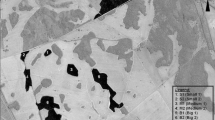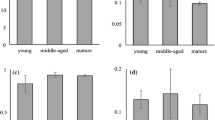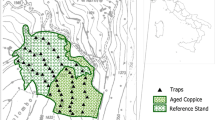Abstract
There are reports suggesting that leaf-cutting ants can act as a biotic filter, selecting plant traits according to foraging preferences, and consequently affecting the species composition of plant communities. In order to test this hypothesis, we evaluated the relationship between the floristic and functional diversity of woody plants in fragments of Semideciduous Seasonal Atlantic Forest (SAF) with the presence or absence of Atta sexdens (Linnaeus, 1758) nests. We expected that, in places where A. sexdens nests is present, 1) floristic diversity is lower and 2) the plant community is dominated by species characterized by greater investment in anti-herbivore defenses and lower nutritional content. For this, we sampled nine SAF fragments in the north of Paraná state, in Brazil. The diversity of woody regenerants (> 1 m in height, < 2 cm diameter) was estimated and 10 functional traits were evaluated: gap dependence, deciduousness, leaf nitrogen and carbon content, leaf C/N ratio, presence of leaf trichomes, leaf thickness, specific leaf area, presence of latex and condensed tannins, for the 28 most abundant woody species. Contrary to expectations, there were no differences in floristic diversity between sites with or without A. sexdens, and functional diversity was also similar, reflecting the floristic similarity. We suggest that the herbivory pressure by A. sexdens on the woody regenerants of SAF fragments is not strong enough to cause significant mortality in individual species and, consequently, affect plant diversity and composition. This may in part be related to the fact that most nests of A. sexdens were established in the edges of the fragments and that ants from these nests forage not only in the forest but also in the agricultural matrix where food resources are abundant. We also suggest that longer-term studies are still needed to fully elucidate the effects of A. sexdens on the plant community of Atlantic Forest fragments.



Similar content being viewed by others
References
Bates D, Maechler M, Bolker B, Walker S, Christensen RHB, Singmann H, Dai B, Grothendieck G (2014) lme4: linear mixed-effects models using Eigen and S4. Journal of Statistical Software, v. 67.
Berish CW (1986) Leaf-cutting ants (Atta cephalotes) select nitrogen-rich forage. Am Midl Nat 115:268–276. https://doi.org/10.2307/2425863
Bhering B, Santos HG, Manzatto CV, Bognola I, Fasolo PJ, Carvalho AP, Rauen MJ (2007) Mapa de solos do estado do Paraná. Embrapa Solos, Rio de Janeiro
Blanton CM, Ewel JJ (1985) Leaf-cutting ant herbivory in successional and agricultural tropical ecosystems. Ecology 66:861–869. https://doi.org/10.2307/1940548
Câmara T, Arnan X, Barbosa VS, Wirth R, Iannuzzi L, Leal IR (2019) Disentangling the effects of foliar vs. floral herbivory of leaf-cutting ants on the plant reproductive success of Miconia nervosa (Smith) Triana (Family Melastomataceae). Bull Entomol Res 110:77–83. https://doi.org/10.1017/S0007485319000294
Carlucci MB, Marcilio-Silva V, Torezan JMD (2021) The Southern Atlantic Forest: Use, Degradation, and Perspectives for Conservation. In: Marques MCM, Grelle CEV (eds) The Atlantic Forest. Springer, Cham
Clarke KR, Warwick RM (2000) Change in Marine Communities: An Approach to Statistical Analysis and Interpretation, 2nd edn. Plymouth, PRIMER-E
Costa AN, Vasconcelos HL, Vieira-Neto EHM, Bruna EM (2008) Do herbivores exert top-down effects in Neotropical savannas? Estimates of biomass consumption by leaf-cutter ants. J Veg Sci 19:849–854. https://doi.org/10.3170/2008-8-18461
Costa AN, Vasconcelos HL, Bruna EM (2016) Biotic drivers of seedling establishment in Neotropical savannas: selective granivory and seedling herbivory by leaf-cutter ants as an ecological filter. J Ecol 105:132–141. https://doi.org/10.1111/1365-2745.12656
den Boer SPA, Baer B, Dreier S, Aron S, Nash DR, Boomsma JJ (2009) Prudent sperm use by leaf-cutter ant queens. Procee Royal Soc London B 276:3945–3953. https://doi.org/10.1098/rspb.2009.1184
Díaz S, Lavorel S, Chapin FS III, Tecco PA, Gurvich DE, Grigulis K (2007) Functional diversity—at the crossroads between ecosystem functioning and environmental filters. In: Canadell JG, Pataki D, Pitelka L (eds) Terrestrial Ecosystems in a Changing World. Springer-Verlag, Berlin Heidelberg, pp 81–91
Dunning JB, Danielson BJ, Pulliam HR (1992) Ecological processes that affect populations in complex landscapes. Oikos 65:169–175. https://doi.org/10.2307/3544901
Farji-Brener AG (2001) Why are leaf-cutting ants more common in early secondary forests than in old-growth tropical forests? An evaluation of the palatable forage hypothesis. Oikos 92:169–177. https://doi.org/10.1034/j.1600-0706.2001.920120.x
Fontana A, Bianchi SR (2017) Carbono e nitrogênio total: analisador elementar. In: Teixeira PC, Donagemma GK, Fontana A, Teixeira WG (eds) Manual de métodos de análise de solo, 3rd edn. Embrapa, Brasília, pp 393–396
Forti LC, Moreira AA, Andrade APP, Castellani MA, Caldato N (2011) Nidificação e arquitetura de ninhos de formigas-cortadeiras. In: Della-Lucia TMC (ed) Formigas-cortadeiras: da bioecologia ao manejo. Editora UFV, Viçosa, pp 102–125
Garcia JM (2022) Fatores que afetam as interações entre as formigas cortadeiras e a vegetação na Mata Atlântica do norte do Paraná. State University of Londrina, Londrina, Thesis
Garcia JM, Bordignon AM, Gonzaga GS, Torezan JMD (2020) Tree seedling responses to leaf-cutting ants herbivory in Atlantic Forest restoration sites. Biotropica 52:884–895. https://doi.org/10.1111/btp.12808
Hagerman AE, Butler LG (1978) Protein precipitation method for the quantitative determination of tannins. J Agric Food Chem 26:809–812. https://doi.org/10.1021/jf60218a027
Holldobler B, Wilson EO (2011) The leafcutter ants: civilization by instinct. W.W. Norton & Company Inc, London
Howard JJ (1987) Leafcutting ant diet selection: the role of nutrients, water, and secondary chemistry. Ecology 68:503–515. https://doi.org/10.2307/1938455
Howard JJ (1988) Leafcutting ant diet selection: relative influence of leaf chemistry and physical features. Ecology 69:250–260. https://doi.org/10.2307/1943180
IBGE- Instituto Brasileiro de Geografia e Estatística (2012) Manual Técnico em Geociências. I: Manual Técnico da Vegetação Brasileira. IBGE, Rio de Janeiro.
Kost C, Oliveira EG, Knoch TA, Wirth R (2005) Spatio-temporal permanence and plasticity of foraging trails in young and mature leaf-cutting ant colonies (Atta spp.). J Trop Ecol 21:677–688. https://doi.org/10.1017/S0266467405002592
Laliberte E, Legendre P (2010) A distance-based framework for measuring functional diversity from multiple traits. Ecology 91:299–305. https://doi.org/10.1890/08-2244.1
Laurance WF, Nascimento HEM, Laurance SG, Andrade A, Fearnside PM, Ribeiro JELS, Chave J, Landau HM (2006) Rain forest fragmentation and the proliferation of successional trees. Ecology 87:469–482. https://doi.org/10.1890/05-0064
Lavorel S, Grigulis K, Mcintyre S, Williams NSG, Garden D, Dorrough J, Berman S, Quétier F, Thebault A, Bonis A (2008) Assessing functional diversity in the field—methodology matters! Funct Ecol 22:134–147. https://doi.org/10.1111/j.1365-2435.2007.01339.x
Legendre P, Legendre L (1998) Numerical Ecology, 2nd edn. Elsevier Science B.V, Amsterdam
Massad TJ, Fincher RM, Smilanich AM, Dyer L (2011) A quantitative evaluation of major plant defense hypotheses, nature versus nurture, and chemistry versus ants. Arthropod-Plant Interactions 5:125–139. https://doi.org/10.1007/s11829-011-9121-z
Mundim FM, Costa AN, Vasconcelos HL (2009) Leaf nutrient content and host plant selection by leaf-cutter ants, Atta laevigata, in a Neotropical savanna. Entomol Exp Appl 130:47–54. https://doi.org/10.1111/j.1570-7458.2008.00789.x
Mundim FM, Bruna EM, Vieira-Neto EHM, Vasconcelos HL (2012) Attack frequency and the tolerance to herbivory of Neotropical savanna trees. Oecologia 168:405–414. https://doi.org/10.1007/s00442-011-2088-8
Nitsche PR, Caramori PH, Ricce WS, Pinto LFD (2019) Atlas climático do estado do Paraná. Instituto Agronômico do Paraná, Londrina.
Oksanen J, Blanchet FG, Friendly M, Kindt R, Legendre P, Mcglinn D, Minchin PR, O'Hara RB, Simpson GL, Solymos P, Stevens MHH, Szoecs E, Wagner H (2018) Vegan: community ecology package. R package version 2.4–4. https://github.com/vegandevs/vegan. Accessed 15 July 2020.
Palmeirim AF, Benchimol M, Leal IR, Peres CA (2021) Drivers of leafcutter ant populations and their inter-trophic relationships in Amazonian forest islands. Ecosphere 12:e03518. https://doi.org/10.1002/ecs2.3518
Pérez-Harguindeguy N et al (2013) New handbook for standardised measurement of plant functional traits worldwide. Aust J Bot 61:167–234. https://doi.org/10.1071/BT12225_CO
Petchey OL, Gaston KJ (2002) Functional diversity (FD), species richness and community composition. Ecol Lett 5:402–411. https://doi.org/10.1046/j.1461-0248.2002.00339.x
Poutasse R (2010) The spatial distribution of Attine ant nests on the Firestone Center for Restoration Ecology, Costa Rica. Thesis, Claremont Colleges, Los Angeles.
Pyke GH, Pulliam HR, Charnov EL (1977) Optimal foraging: a selective review of theory and tests. Q Rev Biol 52:137–154. https://doi.org/10.1086/409852
R Core Team (2019) R: A Language and Environment for Statistical Computing. R Foundation for Statistical Computing. https://www.R-project.org. Accessed 15 June 2021.
Rao M, Terborgh J, Nunez P (2001) Increased herbivory in forest isolates: implications for plant community structure and composition. Conserv Biol 15:624–633. https://doi.org/10.1046/j.1523-1739.2001.015003624.x
Ribeiro-Neto JD, Pinho BX, Meyer ST, Wirth R, Leal IR (2012) Drought stress drives intraspecific choice of food plants by Atta leaf-cutting ants. Entomol Exp Appl 144:209–215. https://doi.org/10.1111/j.1570-7458.2012.01283.x
Shepherd JD (1985) Adjusting foraging effort to resources in adjacent colonies of the leaf-cutter ant, Atta colombica. Biotropica 17:245–252. https://doi.org/10.2307/2388225
Silva PSD, Leal IR, Wirth R, Tabarelli M (2007) Harvesting of Protium heptaphyllum (Aubl.) March. seeds (Burseraceae) by the leaf-cutting ant Atta sexdens L. promotes seed aggregation and seedling mortality. Revista Brasileira De Botânica 30:553–560. https://doi.org/10.1590/S0100-84042007000300019
Silva PSD, Bieber AGD, Leal IR, Wirth R, Tabarelli M (2009) Decreasing abundance of leaf-cutting ants across a chronosequence of advancing Atlantic forest regeneration. J Trop Ecol 25:223–227. https://doi.org/10.1017/S0266467409005823
Silva PSD, Bieber AGD, Knoch TA, Tabarelli M, Leal IR, Wirth R (2013) Foraging in highly dynamic environments: leaf-cutting ants adjust foraging trail networks to pioneer plant availability. Entomologia Exp Applicata. https://doi.org/10.1111/eea.12050
Terborgh J, Lopez L, Nuñez P, Rao M, Shahabuddin G, Orihuela G, Riveros M, Ascanio R, Adler GH, Lambert TD, Balbas L (2001) Ecological meltdown in predator-free forest fragments. Science 294:1923–1925. https://doi.org/10.1126/science.1064397
Torezan JMD (2003) Forest fragmentation and priorities for biodiversity conservation. PhD thesis, University of São Paulo at São Carlos.
Urbas P, Araújo MV Jr, Leal IR, Wirth R (2007) Cutting more from cut forests: edge effects on foraging and herbivory of leaf-cutting ants in Brazil. Biotropica 39:489–495. https://doi.org/10.1111/j.1744-7429.2007.00285.x
Vasconcelos HL (1990) Foraging activity of two species of leaf-cutting ants (Atta) in a primary forest of the central Amazon. Insectes Soc 37:131–145. https://doi.org/10.1007/BF02224026
Vasconcelos HL, Cherrett JM (1997) Leaf-cutting ants and early forest regeneration in central Amazonia: effects of herbivory on tree seedling establishment. J Trop Ecol 13:357–370. https://doi.org/10.1017/S0266467400010567
Violle C, Navas M, Vile D, Kazakou E, Fortunel C, Hummel I, Garnier E (2007) Let the concept of trait be functional. Oikos 116:882–892. https://doi.org/10.1111/j.0030-1299.2007.15559.x
Wirth R, Beyschlag W, Herz H, Ryel RJ, Hölldobler B (2003) The herbivory of leaf-cutting ants: a case study on Atta colombica in the tropical rainforest of Panama. Ecological Studies. v. 164. Berlin, Springer-Verlag, Alemanha.
Zar JH (2010) Biostatistical analysis. Prentice-Hall Inc., New Jersey
Zuur AF, Ieno EN, Walker NJ, Saveliev AA, Smith GM (2009) Mixed effects models and extensions in ecology with R. Statistics for Biology and Health. Springer-Verlag, New York, Series
Acknowledgements
Authors are grateful to Dr. Marco Nogueira, Dr. Nilton Syogo Arakawa, Ms. Ricardo Luis Nascimento de Matos and Dr. Halley Caixeta de Oliveira who allowed the authors to use their laboratories and helped with foliar chemical analyses. The authors also thank Alba Cavalheiro, Odair do Carmo Pavão and Norival Soares do Cabo for their help in the field and in laboratory activities, and ant taxonomist Jacques Hubert Charles Delabie for identifying ant samples.
Funding
The Long-Term Ecological Research Site Mata Atlântica do Norte do Paraná (PELD-MANP) is supported by CNPq (grants 441540/2016-3 and 441510/2020-5) and Fundação Araucária (41872.434.40722.27092013). CNPq provided research grants for the JMDT (309244/2015-3). CAPES provided PhD scholarship to JMG (“Financial Code 001”) and a Scientific Initiation scholarship to LCDR (88887.505837/2020-00).
Author information
Authors and Affiliations
Contributions
All authors agree to submission of the manuscript. JMG, JMDT and LCDR conceived the research and wrote the text; JMG and LCDR did the field and laboratory work; JMG, LCDR and LCSMP performed statistical analysis; JMG, JMDT, HLV, LCDR and LCSMP edited the manuscript.
Corresponding author
Ethics declarations
Conflict of interest
The authors declare no conflict of interest.
Additional information
Communicated by Elizabeth Pringle.
Publisher's Note
Springer Nature remains neutral with regard to jurisdictional claims in published maps and institutional affiliations.
Supplementary Information
Below is the link to the electronic supplementary material.
Rights and permissions
Springer Nature or its licensor (e.g. a society or other partner) holds exclusive rights to this article under a publishing agreement with the author(s) or other rightsholder(s); author self-archiving of the accepted manuscript version of this article is solely governed by the terms of such publishing agreement and applicable law.
About this article
Cite this article
Garcia, J.M., Cerqueira Dias Rodrigues, L., Pereira, L.C.d.M. et al. Influence of the leaf-cutting ant Atta sexdens Linnaeus (1758) on the taxonomic and functional diversity of woody plants in Atlantic Forest fragments. Plant Ecol (2024). https://doi.org/10.1007/s11258-024-01425-6
Received:
Accepted:
Published:
DOI: https://doi.org/10.1007/s11258-024-01425-6




